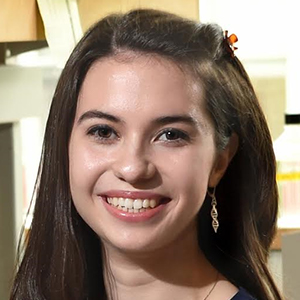Schooled (and steeled)
by invisible illness
I spent my 20th birthday in the emergency room. My friends had planned a festive breakfast and matching outfits, but at 5 a.m. I was lying in my bed in agony thinking, “If I can get through my 8 a.m. biochemistry lab, then I’ll go to the ER.” But I couldn’t wait. At the hospital, every time I repeated my date of birth to a nurse, I waited for the reluctant “Oh … well, happy birthday …” as I lay there high on pain killers and on so much muscle relaxant I was choking on my own saliva.
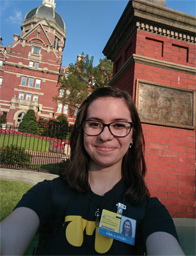 On her 22nd birthday, Erica Avery posed outside Johns Hopkins Hospital in the same Batman T-shirt she was wearing when she was hospitalized for fibromyalgia symptoms two years before.Photo courtesy of Erica Avery
On her 22nd birthday, Erica Avery posed outside Johns Hopkins Hospital in the same Batman T-shirt she was wearing when she was hospitalized for fibromyalgia symptoms two years before.Photo courtesy of Erica Avery
Two years earlier, in my first month as an undergraduate, I’d woken up one morning with pain in my right elbow. It hurt too much to take notes in genetics class — I thought maybe I’d slept on it wrong. The pain got worse and rapidly spread to every inch of my body; then came fatigue, allodynia, cognitive dysfunctions, irritable bowel, sleep disorder, depression and other symptoms.
Eventually, I was passing out, losing weight from not eating and ultimately bedridden. My life came to a screeching halt; I was beyond scared. I wondered if I had multiple sclerosis, ankylosing spondylitis, lupus, even osteosarcoma, or if I was just going insane. I felt isolated and helpless.
Eight months after that initial pain and after every test imaginable, I was diagnosed with fibromyalgia syndrome. It was a relief to have an answer, even if it wasn’t exactly good news. Incurable and chronic, fibromyalgia literally means “pain in muscles and fibrous tissues” — its hallmark symptom. Little is known about fibro, and drugs barely take the edge off. I would never be the same again.
I’d seen commercials for Lyrica (the drug I’m on now), so the diagnosis didn’t surprise me. I knew it as “overactive nerves” that caused pain, fatigue and overall sensory amplification, as described on TV, but my idea and my experience couldn’t have been more different. I thought it meant aches here and there, not this unyielding hell. My physical therapist described it as a “never-ending migraine all over your body, plus all the other symptoms.” Moreover, fatigue doesn’t mean “I’m tired.” Fatigue means “I feel like I just got hit by a bus after running a marathon when I haven’t slept in a week.” While learning gas laws in freshman chemistry, my eyes suddenly couldn’t focus on the equations on the board; I couldn’t control my vision. I left and called my mother, who discovered that fatigue even affects the tiny muscles in the back of the eye.
Medicine’s best guess is that fibromyalgia’s onset is caused by some trauma — abuse, a car accident, chronic stress — that makes the nervous system go haywire. There exists a high comorbidity with post-traumatic stress disorder. Also, 90 percent of patients are women, with an average age of onset of about 40.
Doctors don’t tell you that pain and fatigue come with more obscure symptoms that are just as severe. The brain fog, memory loss and speech impairment made me feel like I had dementia. In the car, I’d forget where I was going. In public, I’d forget how I got there or who I was with. I’d fumble over words midsentence, forget what I was saying entirely or forget whole conversations. I couldn’t think or concentrate. Initially, I asked my doctor what treatment options there were for fibro fog, and he responded, “What’s fibro fog? I’ve never heard of that.” Through my own research, I found that lecithin supplements — which predominantly contain phospholipids — improve cognitive function.
I was just on my own, figuring out the real world and adulthood as a college freshman, when suddenly I didn’t think I’d get through a degree. I was in crisis mode. I couldn’t take care of myself.
But then I found the fight in me. My muscles don’t work properly; they’re weak, stiff and painful beyond words, but I learned to walk again when I could barely cross a room. I thought about my mother’s numerous miscarriages in her struggle to have a family. I thought about my grandfather’s Purple Heart, which I later had tattooed on my back in the spot where the sniper round left his body, to tell myself not to let suffering consume me. Driven by their resolve, I found that redeveloping endurance and strength in my body seemed attainable.
I’ve endured judgment, criticism, misunderstanding and even discrimination. When my speech was impaired in a professor’s office, I asked, “Do you understand what I’m trying to say?” To which she replied, “No, because you’re a college student who can’t even complete your sentences.” Sophomore year, my boyfriend broke up with me, saying, “I can’t handle that you’re sick.” When I couldn’t finish an experiment because I had severe serotonin poisoning after starting the drug Cymbalta, my roommate called me irresponsible and disorganized. Meanwhile, I began having seizures. She said I was a burden, and I felt guilty and sorry for her as I vomited from the drug’s side effects.
During a conversation with my rheumatologist, I used the word “disability.” He looked at me and said, “You’re not disabled. It’s not like you have arthritis,” and wouldn’t sign paperwork allowing the university’s public safety officers to transport me to class. I once explained to an acquaintance how my pathology means my muscles get stiff without provocation in a way healthy muscles don’t; he responded, “You think you’ve got it bad, my shoulders are actually like rocks” — comparing his stress and tension to my disease.
Fibromyalgia affects up to a whopping 8 percent of Americans, but because we look normal, many people are clueless, and some don’t even believe it’s real. There’s no test for it. The diagnosis is based on symptoms. This doesn’t mean there isn’t a biomarker for which a test could eventually be developed; it means people lack empathy.
I am grateful for those who’ve been truly kind. A professor once reassured me, “Refusing special treatment isn’t the way to beat this. Accepting help isn’t giving up.” There’s a PI with an autoimmune disease of her own, a yoga teacher who is a fellow fibro patient, and a best friend who thoroughly understands how to take my symptoms into consideration without pitying me. Complete strangers have offered me tea, phone numbers, books to read, words of encouragement and prolonged hugs and shoulders to cry on when I broke down in a support group. “I know you can still be happy” are the words that stay with me.
I’ve adapted to a new way of living. I cut off all my hair because the nerve pain was unbearable when I lifted my arms to wash or brush it. I fight like Hercules just to get out of bed every morning — that’s my impossible labor. Once-mundane tasks like taking a shower leave me out of breath.
To meet my needs, I now operate at my own pace. My MRI showed the postural defects caused by weak and tight muscles that pulled out the curvature in the vertebra of my neck, a condition known as “military neck.” To minimize flares, I take the bus, because the posture needed for driving affects muscle tension, causing swelling in my occipital nerves. I receive regular massages and often interrupt my days to go to physical therapy or at least do some stretches in between tasks.
I bring my fight to the lab every day; this disability makes me a better student. My unique perspective as a patient and scientist gives me an advantage. I know what it’s like to desperately need answers and to have one’s quality of life depend on them. Every day with a mysterious pathology of my own, I experience firsthand why research is important and how there’s still so much we don’t know. I rotated in a lab that studied skeletal muscle physiology and couldn’t help but wonder what was happening with mine. When I first learned how mitochondria produce energy, having mitochondrial dysfunction of my own made me realize how much can go wrong. I appreciated just how my CoQ10, alpha lipoic acid and malate supplements help my mitos. I didn’t just know the facts; I lived them.
I’ve found my own way of doing things, and whatever the task, I’ve made it work, just like writing a new protocol. Because of my body’s limits, I’ve learned to keep trying and figuring out new approaches as we do in the lab after setbacks. Getting around problems and being patient but tenacious with experiments is something I learned first with my body. I’ve been troubleshooting my daily routine for years with supplements and medications, diets, exercises and other therapies.
I’ve tried acupuncture, hyperbaric oxygen chambers and sensory deprivation salt float tanks — I’ve even been to hypnotists, reiki healers, shamans and mediums.With an invisible illness, I must communicate effectively to people who will never fully understand, just as scientists often do. For my undergrad senior seminar class, we had to do 45-minute presentations from a collection of publications on a topic of our choice. Talking about my illness, I struggled and fought back tears, but I didn’t care about the grade. I knew what this was meant to teach me.
Illness is a journey — just like grad school. I push through and learn from failure one day at a time. Walk just a little bit more today. Know it’s OK that I failed to submit my homework by deadline. Don’t give up on yoga because I struggle with simple poses. Every day I come to lab is a success; even if my experiment doesn’t work, having the motivation to try is a triumph. I take small victories where I can get them.
My body needs me to listen to it. A professor once asked, “How are you supposed to handle the stress of grad school if you’re ill?” I think I’m better equipped to handle stress than if I didn’t have this illness to teach me how. I know how to manage my time and ignore negativity. I don’t pull all-nighters or drink coffee or energy drinks.
Tasks are tougher now, but so am I. The pain in my elbow that kept me from taking notes that first day is nothing compared to what I push through now. I refuse to let this illness take my life from me. I know now this isn’t for others to understand. I’ve stopped comparing myself to people. I am on my path. I have fibromyalgia, but it doesn’t have me.
Each birthday since my 20th, I’ve worn the same Batman T-shirt I went to the hospital in. Now I’m a grad student at Johns Hopkins, and for my last birthday I took a picture outside Hopkins Hospital — not inside — demonstrating how far I’ve come. While I know that grad school will bring its own unique set of obstacles — a rigorous workload, project pitfalls, a loss of direction or ample criticism — I also know that I can face them. I’ve surprised myself with what I’ve been able to face so far.
Enjoy reading ASBMB Today?
Become a member to receive the print edition monthly and the digital edition weekly.
Learn moreGet the latest from ASBMB Today
Enter your email address, and we’ll send you a weekly email with recent articles, interviews and more.
Latest in Opinions
Opinions highlights or most popular articles
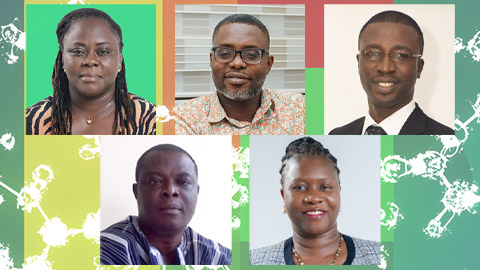
Getting to know scientists half a world away
In a program at Wellesley College, students interview and write about researchers at a university in Ghana.

Let’s make ASBMB awardees look more like BMB scientists
Think about nominating someone outside your immediate network.
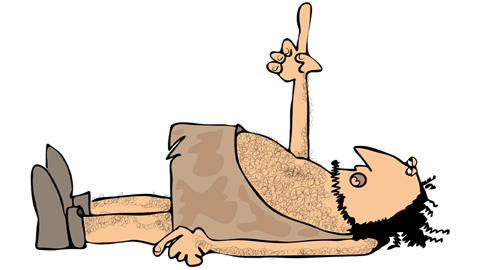
A paleolithic peer review
You might think review panels have only been around for the last century or so. You would be mistaken.

Early COVID-19 research is riddled with poor methods and low-quality results
The pandemic worsened, but didn’t create, this problem for science.

So, you went to a conference. Now what?
Once you return to normal lab life, how can you make use of everything you learned?
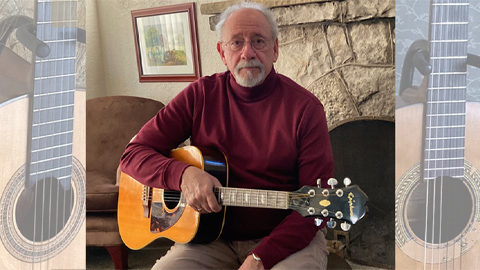
My guitar companion
A scientist takes a musical journey through time and around the world.

